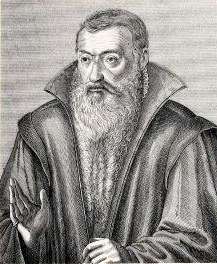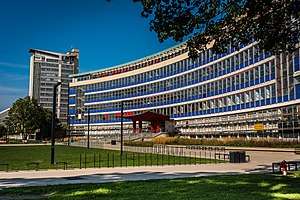University of Strasbourg
The University of Strasbourg (French: Université de Strasbourg, Unistra) in Strasbourg, Alsace, France, is a university in France with over 52,000 students[2] and almost 3,300 researchers.[4]
Université de Strasbourg | |
 | |
| Latin: Universitas Argentorati | |
| Type | Public |
|---|---|
| Established | 1538 |
| Budget | €536 million (2019)[1] |
| President | Father Michel Deneken |
| Students | 52,144[2] |
| 2,265[3] | |
| Location | , , France |
| Affiliations | LERU, Utrecht Network AACSB, EFMD, EUCOR |
| Website | www.unistra.fr |

.jpg)
The French university traces its history to the earlier German-language Universität Straßburg, which was founded in 1538, and was divided in the 1970s into three separate institutions: Louis Pasteur University, Marc Bloch University, and Robert Schuman University. On 1 January 2009, the fusion of these three universities reconstituted a united University of Strasbourg. With as many as 19 Nobel laureates, and two Fields Medal winners, the university is ranked among the best in the League of European Research Universities.
History
The university emerged from a Lutheran humanist German Gymnasium, founded in 1538 by Johannes Sturm in the Free Imperial City of Strassburg. It was transformed to a university in 1621 (German: Universität Straßburg) and elevated to the ranks of a royal university in 1631. Among its earliest university students was Johann Scheffler who studied medicine and later converted to Catholicism and became the mystic and poet Angelus Silesius.[5]
The Lutheran German university still persisted even after the annexation of the City by King Louis XIV in 1681 (one famous student was Johann Wolfgang von Goethe in 1770/71), but mainly turned into a French speaking university during the French Revolution.
The university was refounded as the German Kaiser-Wilhelm-Universität in 1872, after the Franco-Prussian war and the annexation of Alsace-Lorraine to Germany provoked a westwards exodus of Francophone teachers. During the German Empire the university was greatly expanded and numerous new buildings were erected because the university was intended to be a showcase of German against French culture in Alsace. In 1918, Alsace-Lorraine was returned to France, so a reverse exodus of Germanophone teachers took place.
During the Second World War, when France was occupied, personnel and equipment of the University of Strasbourg were transferred to Clermont-Ferrand. In its place, the short-lived German Reichsuniversität Straßburg was created.
In 1971, the university was subdivided into three separate institutions:
- Louis Pasteur University (Strasbourg I)
- Marc Bloch University (Strasbourg II)
- Robert Schuman University (Strasbourg III)
These were, however, reunited in 2009, and were able to be among the first twenty French universities to gain greater autonomy.[6]
Buildings
.jpg)
The university campus covers a vast part near the center of the city, located between the "Cité Administrative", "Esplanade" and "Gallia" bus-tram stations.
Modern architectural buildings include: Escarpe, the Doctoral College of Strasbourg, Supramolecular Science and Engineering Institute (ISIS), Atrium, Pangloss, PEGE (Pôle européen de gestion et d'économie) and others. The student residence building for the Doctoral College of Strasbourg was designed by London-based Nicholas Hare Architects in 2007. The structures are depicted on the main inner wall of the Esplanade university restaurant, accompanied by the names of their architects and years of establishment.
The administrative organisms, attached to the university (Prefecture; CAF, LMDE, MGEL—health insurance; SNCF—national French railway company; CTS—Strasbourg urban transportation company), are located in the "Agora" building.
.jpg) The Gallia building, formerly Germania, seat of the Regional Student's Service Centre
The Gallia building, formerly Germania, seat of the Regional Student's Service Centre Main Law faculty building of the former Robert Schuman University
Main Law faculty building of the former Robert Schuman University- Main building of the university for economic and management studies (AKA : PEGE - Pôle Européen de gestion et d'économie)
.png) The National and University Library on Place de la République, former Kaiserplatz
The National and University Library on Place de la République, former Kaiserplatz
Nobel laureates
- Karl Ferdinand Braun
- Paul Ehrlich
- Hermann Emil Fischer
- Jules Hoffmann
- Albrecht Kossel
- Martin Karplus
- Charles Louis Alphonse Laveran
- Jean-Marie Lehn
- Otto Loewi
- Otto Fritz Meyerhof
- Louis Néel
- Wilhelm Röntgen
- Albert Schweitzer
- Hermann Staudinger
- Adolf von Baeyer
- Max von Laue
- Pieter Zeeman
- Jean-Pierre Sauvage
Notable academics and alumni, by year of birth
- Johannes Sturm (1507–1589)
- Johannes Nicolaus Furichius (1602-1633)
- Johann Conrad Dannhauer (1603–1666)
- Angelus Silesius (Johann Scheffler) (1624-1677)
- Philipp Jacob Spener (1635–1705)
- Antoine Deparcieux (1703–1768)
- Johann Hermann (1738–1800)
- Mikhail Illarionovich Kutuzov (1745–1813)
- Johann Peter Frank (1745–1821)
- Dominique Villars (1745–1841)
- Johann Wolfgang von Goethe (1749–1832)
- Louis Ramond de Carbonnières (1755–1827)
- Maximilian von Montgelas (1759–1838)
- Klemens Wenzel von Metternich (1773–1859)
- Jean Lobstein (1777–1835)
- Georg Büchner (1813–1837)
- Charles Frédéric Gerhardt (1816–1856)
- Emil Kopp (1817–1875)
- Charles-Adolphe Wurtz (1817–1884)
- Auguste Nefftzer (1820–1876)
- August Kayser (*1821-1885)
- Louis Pasteur (1822–1895)
- Adolph Kussmaul (1822–1902)
- Ambroise-Auguste Liébeault (1823–1904)
- Georg Albert Lücke (1829–1894)
- Paul Schützenberger (1829–1897)
- Anton de Bary (1831–1888)
- Friedrich Daniel von Recklinghausen (1833–1910)
- Adolf von Baeyer (1835–1917), Nobel Prize 1905
- Adolf Michaelis (1835–1910)
- Heinrich Wilhelm Gottfried von Waldeyer-Hartz (1836–1921)
- Oswald Schmiedeberg (1838–1921)
- Gustav von Schmoller (1838–1917)
- August Kundt (1839–1894)
- Bernhard Naunyn (1839–1925)
- Friedrich Kohlrausch (1840–1910)
- Rudolph Sohm (1841-1917)
- Heinrich Martin Weber (1842–1913)
- Paul Heinrich von Groth (1843–1927)
- Lujo Brentano (1844–1931)
- Gustav Schwalbe (1844–1916)
- Charles Louis Alphonse Laveran (1845–1922), Nobel Prize 1907
- Wilhelm Röntgen (1845–1923), Nobel Prize 1901
- Harry Bresslau (1848–1926)
- Ernst Remak (1849–1911)
- Josef von Mering (1849–1908)
- Georg Dehio (1850–1932)
- Karl Ferdinand Braun (1850–1918), Nobel Prize 1909
- Hans Chiari (1851–1916)
- Hermann Emil Fischer (1851–1919), Nobel Prize 1902
- Albrecht Kossel (1853–1927), Nobel Prize 1910
- Paul Ehrlich (1854–1915), Nobel Prize 1908
- Emil Cohn (1854–1944)
- Ludwig Döderlein (1855–1936)
- Otto Lehmann (1855–1922)
- Theobald von Bethmann Hollweg (1856–1921)
- Georg Simmel (1858–1918)
- Oskar Minkowski (1858–1931)
- Othmar Zeidler (1859–1911)
- Geerhardus Vos (1862–1949)
- Andreas von Tuhr (1864–1925)
- Pierre Weiss (1865–1940)
- Pieter Zeeman (1865-1943), Nobel Prize 1902
- Eugen Hirschfeld (1866-1946)
- Gustav Anrich (1867–1930)
- Georg Thilenius (1868–1937)
- Gustav Landauer (1870–1919)
- Franz Weidenreich (1873–1948)
- Otto Loewi (1873–1961), Nobel Prize 1936
- Karl Schwarzschild (1873–1916)
- Erwin Baur (1875–1933)
- Albert Schweitzer (1875–1965), Nobel Prize 1952
- Ernest Esclangon (1876–1954)
- Paul Rohmer (1876–1977)
- Maurice René Fréchet (1878–1973)
- Helene Bresslau Schweitzer (1879–1957)
- Max von Laue (1879–1960), Nobel Prize 1914
- Leonid Mandelstam (1879–1944)
- René Leriche (1879–1955)
- Nikolai Papaleksi (1880–1947)
- Hans Kniep (1881–1930)
- Hermann Staudinger (1881–1965), Nobel Prize 1953
- Otto Fritz Meyerhof (1884–1951), Nobel Prize 1922
- Pablo Groeber (1885–1964)
- Pierre Montet (1885–1966)
- Marc Bloch (1886–1944)
- Robert Schuman (1886–1963)
- Ernst Robert Curtius (1886–1956)
- Hans Schlossberger (1887–1960)
- Friedrich Wilhelm Levi (1888–1966)
- Carl Schmitt (1888–1985)
- Beno Gutenberg (1889–1960)
- André Danjon (1890–1967)
- Pauline Alderman (1893–1983)
- Henri Lefebvre (1901–1991)
- Michel Mouskhely (1903–1964)
- Jean Cavaillès (1903–1944)
- Louis Néel (1904–2000), Nobel Prize 1970
- Henri Cartan (1904–2008)
- Ernst Anrich (1906–2001)
- Emmanuel Levinas (1906–1995)
- Maurice Blanchot (1907-2003)
- Michael Ellis DeBakey (1908–2008)
- Antoinette Feuerwerker (1912–2003)
- Salomon Gluck (1914–1944)
- Hicri Fişek (1918–2002)
- Lucien Braun (1923–2020)
- René Thom (1923–2002), Fields Medal 1958
- Robert Preus (1924-1995)
- Francis Rapp (1926–2020)
- Milton Santos (1926–2001), Vautrin Lud Prize 1994
- Gabriel Vahanian (*1927)
- Martin Karplus (*1930), Nobel Prize 2013
- Yves Michaud (*1930)
- Pierre Chambon (*1931)
- John Warwick Montgomery (*1931)
- Zemaryalai Tarzi (*1933)
- Alberto Fujimori (*1938)
- Liliane Ackermann (1938–2007)
- Jean-Marie Lehn (*1939), Nobel Prize 1987
- Philippe Lacoue-Labarthe (1940–2007)
- Jean-Luc Nancy (*1940)
- Jules A. Hoffmann (*1941), Nobel Prize 2011
- Katia Krafft (1942–1991)
- Jean-Pierre Sauvage (*1944), Nobel Prize 2016
- Moncef Marzouki (*1945)
- Maurice Krafft (1946–1991)
- Jacques Marescaux (*1948)
- Arsène Wenger (*1949)
- Jürgen Wöhler (*1950)
- Patrick Strzoda (*1952)
- Jean-Claude Juncker (*1954)
- Thomas Ebbesen (*1954)
- Luc Grethen (*1964)
Rankings
| University rankings | |
|---|---|
| Global – Overall | |
| ARWU World[8] | 101-150 |
| THE World[9] | 351-400 |
| USNWR Global[10] | 187 |
| QS World[11] | 303 |
See also
- Reichsuniversität Straßburg
- Jardin botanique de l'Université de Strasbourg
- List of early modern universities in Europe
- On the Poverty of Student Life
- Musée de minéralogie
- Musée zoologique de la ville de Strasbourg
References
- "Budget". University of Strasbourg. Retrieved 15 November 2019.
- "Chiffres clés". University of Strasbourg. Retrieved 15 November 2019.
- "Formation doctorale". University of Strasbourg. Retrieved 15 November 2019.
- "Personnel". University of Strasbourg. Retrieved 15 November 2019.
- Paterson, Hugh Sinclair; Exell, Joseph Samuel (October 1870). "Angelus Silesius: Physician, Priest and Poet". The British & Foreign Evangelical Review. XIX. London: James Nisbet & Co. pp. 682–700, based in large part on Kahlert, August (Dr.). Angelus Silesius: Ein literar-historiche Untersuchung (Breslau: s.n., 1853).
- "Décret n° 2008-787 portant création de l'université de Strasbourg" (in French). legifrance.gouv.fr. 18 August 2008. Retrieved 21 June 2009.
- See commemorative plaque Palais Universitaire de Strasbourg-10 août 1949
- Academic Ranking of World Universities 2018
- "World University Rankings". Times Higher Education (THE). 18 August 2017.
- "U.S. News Education: Best Global Universities 2018". usnews.com.
- "QS World University Rankings 2018". Top Universities. 1 February 2017.
External links
| Wikimedia Commons has media related to University of Strasbourg. |